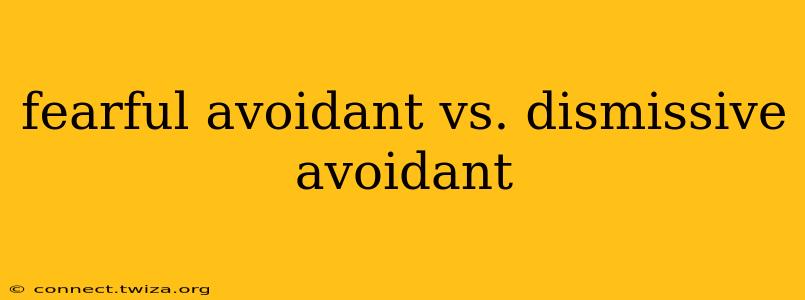Fearful-Avoidant vs. Dismissive-Avoidant Attachment Styles: Understanding the Key Differences
Attachment theory, a cornerstone of psychology, helps us understand how our early childhood experiences shape our adult relationships. Two prominent attachment styles often cause confusion: fearful-avoidant and dismissive-avoidant. While both involve avoidance, their underlying motivations and behavioral manifestations differ significantly. This article delves into the nuances of each style, clarifying their distinct characteristics and helping you better understand these complex relationship patterns.
What is Fearful-Avoidant Attachment?
Fearful-avoidant attachment, also known as anxious-preoccupied attachment, stems from inconsistent caregiving in childhood. These individuals experienced unpredictable emotional availability from their caregivers. Sometimes they received love and support; other times, they faced neglect or rejection. This inconsistency creates a deep internal conflict: a strong desire for intimacy coupled with an intense fear of abandonment and rejection.
Characteristics of Fearful-Avoidant Attachment:
- High anxiety and avoidance: They crave closeness but simultaneously fear being hurt. This leads to a paradoxical behavior pattern of seeking intimacy while simultaneously pushing people away.
- Ambivalence: They experience intense emotional swings, oscillating between feelings of love and hate, closeness and distance.
- Fear of intimacy: While wanting connection, the fear of rejection and vulnerability often sabotages their efforts.
- Inconsistent self-esteem: Their self-worth is heavily dependent on external validation, leading to fluctuating self-image.
- Relationship patterns: They often struggle to maintain stable relationships due to their fluctuating needs and anxieties. They may cling to partners one moment and withdraw the next.
What is Dismissive-Avoidant Attachment?
Dismissive-avoidant attachment results from a childhood environment characterized by emotional unavailability or rejection. Unlike fearful-avoidants, however, these individuals develop a defense mechanism of emotional detachment to cope with this lack of support. They suppress their emotional needs and prioritize independence.
Characteristics of Dismissive-Avoidant Attachment:
- Low anxiety and high avoidance: They are comfortable being alone and prioritize self-reliance. Intimacy feels threatening or overwhelming.
- Emotional suppression: They often minimize or deny their feelings, appearing aloof or distant.
- High self-reliance: They are independent and self-sufficient, sometimes to the point of self-reliance becoming a barrier to forming meaningful connections.
- Difficulty with vulnerability: Sharing emotions or seeking support feels weak or uncomfortable.
- Relationship patterns: They tend to avoid close relationships or engage in relationships characterized by emotional distance and lack of emotional intimacy. They may appear emotionally unavailable or uninterested in their partner's feelings.
What are the Key Differences Between Fearful-Avoidant and Dismissive-Avoidant Attachment?
The core difference lies in the level of anxiety and the underlying coping mechanism. Fearful-avoidants experience high anxiety and vacillate between wanting closeness and fearing rejection. Dismissive-avoidants, on the other hand, have low anxiety and avoid intimacy altogether as a defense mechanism.
| Feature | Fearful-Avoidant | Dismissive-Avoidant |
|---|---|---|
| Anxiety Level | High | Low |
| Avoidance Level | High | High |
| Emotional Needs | Strong desire for intimacy, but fear | Strong suppression of emotional needs |
| Self-Esteem | Inconsistent, dependent on validation | High, but often based on self-reliance |
| Relationship Style | Clingy and distant; unstable | Distant, emotionally unavailable; independent |
How Do These Attachment Styles Affect Relationships?
Both fearful-avoidant and dismissive-avoidant attachment styles can create significant challenges in romantic relationships. Fearful-avoidants might struggle with jealousy, insecurity, and constant reassurance-seeking. Dismissive-avoidants may appear cold, distant, and unresponsive to their partner's emotional needs. These relational patterns can lead to conflict, misunderstandings, and ultimately, relationship dissolution.
Can These Attachment Styles Change?
While attachment styles are deeply ingrained, they are not immutable. Through self-awareness, therapy, and conscious effort, individuals can learn to understand and manage their attachment patterns. Therapy, particularly attachment-based therapy, can help individuals identify the root causes of their attachment style and develop healthier relationship patterns.
What if I think I have a Fearful-Avoidant or Dismissive-Avoidant Attachment Style?
If you suspect you have one of these attachment styles, consider seeking professional help. A therapist can provide a proper diagnosis and create a personalized plan to help you navigate your relationship challenges and foster healthier connection. Self-help resources such as books and workshops can also be valuable in improving self-awareness and developing more adaptive relationship skills. Remember, understanding your attachment style is the first step towards building more fulfilling and secure relationships.
